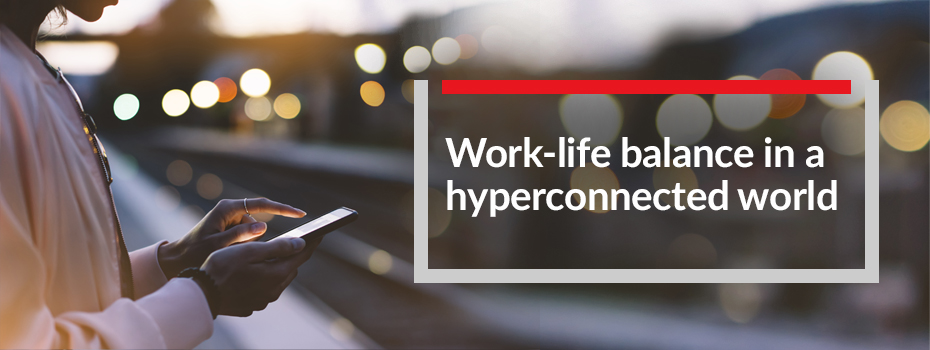Work-life balance in a hyperconnected world

Feeling torn between work and all of the other things in life is a common conundrum. For the last two decades, the topic of work-life balance has been a popular one.
A good work-life balance “means you have harmony between different aspects of your life, where benefits gained from each area can support and strengthen the others.”
Organisations have strived to lead the way and attract the best talent with wellness programs and work-life balance initiatives. Figures from the Australian Bureau of Statistics also show that the average number of hours worked by employed Australians is decreasing. During the 1980s, we were working on average almost 35 hours per week while the first decade of the 2000s we decreased those hours to 33.
However, there is another trend revolutionising the way we work. AI, IoT, cloud-based platforms and other technology is allowing us to work in powerful new ways. We can work more efficiently and flexibly than ever before, gain insights that transform decision-making and innovate the way we deliver services.
What does the rise of technology mean for work-life balance?
Technology and wellness
Fast and affordable internet access, devices to suit any occasion, and cloud platforms allow us the flexibility to work anywhere, at any time.
Uber, Airtasker, Expert360 and a multitude of other platforms have sprung up to feed our desire to work on our own terms.
Co-working spaces, where freelancers can find all the workplace essentials along with opportunities to network and socialise, are also growing in popularity. Reports suggest co-working spaces in Melbourne have grown by 960 per cent over the past three years, with the city home to almost half of Australia's co-work spaces.
Meanwhile, AI, IoT and other tech are removing the mundane and tedium from our workdays, streamlining processes and giving us the freedom to focus on creativity, decision-making and other more human elements of our work.
As we enjoy the benefits, technology is also presenting a new dilemma. Where and when does our “work” end and our “life” – away from work – start?
Is technology putting work-life balance in danger?
You leave the office early, planning to check your emails during the evening. Is this your choice to check your emails or do you feel obligated?
Later on, you check your emails and discover a problem has flared up, so you spend an hour or so sorting it out – rather than reading a book to your 6-year old and watching your favourite TV show. The next day, you’re so relieved you sorted the problem out as it would’ve taken hours more to sort out the next day and could have potentially been an extremely costly exercise.
This scenario illustrates the positives and negatives that technology brings to our working lives. While we enjoy the flexibility, it comes at a cost. Bringing stress into your family home and the feeling of never being off duty can increase your mental load and add up to stress.
It’s not just the evenings, either. Work continually creeps into “life”. Should you take that call during your lunch break? Should you take the laptop on holiday?
For those who want the ultimate in flexibility – freelance and contract work – the disadvantages don’t stop there. Workers and unions are concerned about loss of protections such as sick leave, superannuation and unfair dismissal. In one recent case, the Fair Work Commission determined that an Uber driver was not an employee and therefore ineligible to make a claim for unfair dismissal.
The lack of a guaranteed income also doesn’t bode well for achieving that dream of becoming a homeowner, with lenders traditionally a cautious bunch.
The other side of the coin: benefits for both employee and employer
It is a double-edged sword, but the new way of working is here to stay – and the potential benefits are huge for those that seize the opportunities that technology brings.
Tasks that were once dreaded can be simplified and sped up beyond recognition. Productivity can skyrocket, and tools that enhance communication and connection can fuel unprecedented collaboration.
Still feeling stressed? There’s an app for that. Things like mindfulness and meditation can easily be incorporated into your daily routine thanks to smartphone technology. And there’s also a reminder you can set to alert you when you’ve gone over your daily screen time target.
Want to add new skills to your toolkit? Why not pause for a little micro-learning.
Employers are also reaping the rewards, with access to expert talent, faster hiring turnaround times and tech that promotes productivity, engagement and innovation.
Instead of focusing on work-life balance, the key to ensuring both workers and employers thrive into the future may be to focus on the newer concept of work-life integration. Rather than creating an artificial barrier between the two, is it time we learn how to successfully blend work and life?
For more information on data security, mandatory data breach notification, cybersecurity and strategy, check out Practical Guidance Cybersecurity, Data Protection and Privacy.
From simple search to analysis and insight, the powerful intelligence of Lexis Advance sits at the heart of many of LexisNexis' legal solutions. Access exactly what you need with a single subscription.
 LexisNexis
LexisNexis